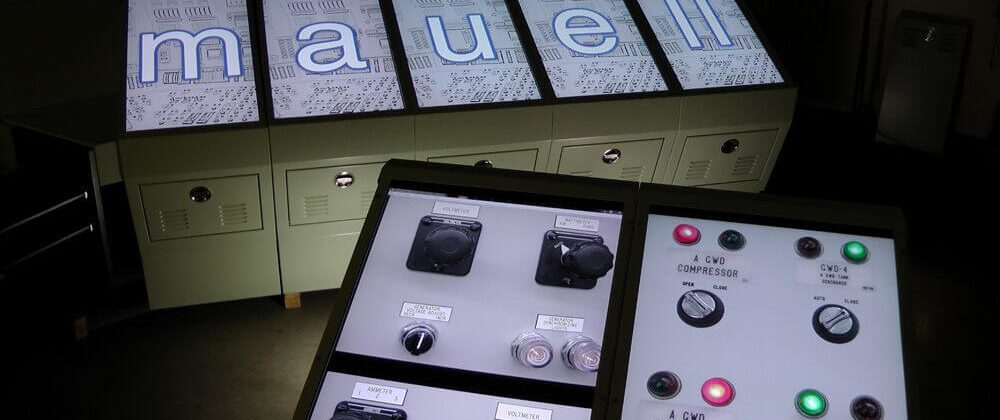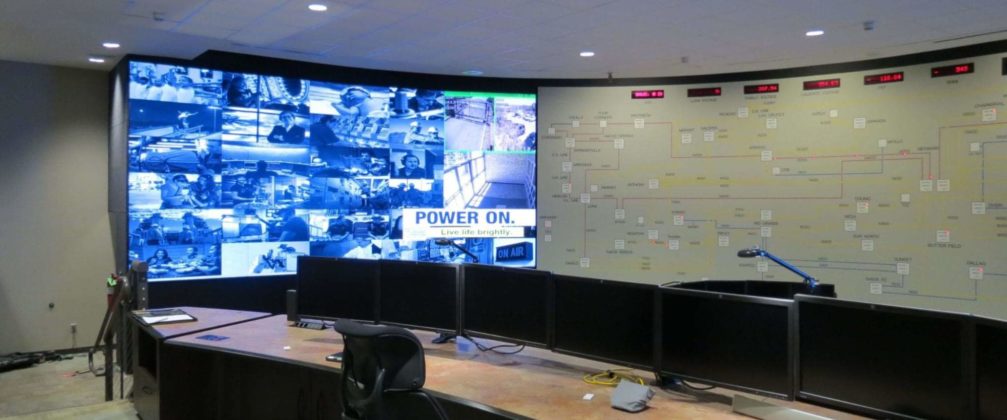Facilities across a wide variety of industries use control room simulation training to provide initial and ongoing instruction for their employees. Simulation training continues to evolve with a goal of emulating real-world conditions with the highest degree of fidelity. In this blog, we’ll take a closer look at how three different industries utilize simulators (and simulations) to train their employees.
What Is a Simulator?
Depending on the context, the word “simulator” can have many different meanings. In this blog, we’re referring to simulator panels used to train employees in a variety of industries. Control room simulators typically break down into two categories: hard panel and soft panel.
Hard Panel Simulators
Hard panel simulators reproduce the exact feel of buttons, switches, and meters to provide a high-fidelity training experience. Companies like Mauell can replicate the tension and resistance of each part to create fully-immersive training scenarios.
Hard panel simulators are typically custom-built for specific facilities, such as electric or nuclear power plants. As such, they’re more expensive than soft panel simulators.
Soft Panel Simulators
Soft panel simulators are LED touch screens that trainees touch to move switches and push buttons. They don’t reproduce the actual feel of the components, but the positioning of each part and overall look replicates the original control panel.
These simulators offer more flexibility than hard panel options because they can be repositioned based on how employees actually use them. They’re also more portable and can be moved to wherever there’s training space. And because they’re not re-engineered like hard panels, they’re a more economical option.
Now that we’ve defined “simulators” within the context of this blog, we’ll move into several industries that benefit from using them.
Industry #1: Defense (United States Navy)
When you think of military simulators, your mind probably goes straight to flight simulators. However, the U.S. Air Force isn’t the only branch of the military that uses simulators for training. The U.S. Navy also uses simulators that mimic the look of ship bridges (both interior and exterior) for training purposes.
Simulation training helps Naval personnel learn where controls are and how they can be manipulated to perform specific tasks. It also provides opportunities for them to practice using backup equipment that may be necessary during emergencies.
The Navy uses simulator panels for a variety of training purposes in both ship- and shore-based settings. In most cases, non-tactical mission training takes place when ships are in port. These training exercises include:
- Teaching maintenance procedures
- Familiarizing engineering personnel with control systems
- Teaching ship-handling skills
- Training radar navigation personnel
Depending on the situation, simulators may be constructed as part of the ship procurement contract. Incorporating simulation into the design of the ship and its training plans can often produce valuable cost reductions.

The Navy typically employs three types of simulation training: live, virtual, and constructive. We’ll take a closer look at each training category below.
Live Simulation
With live simulation, actual trainees operate real equipment. However, a particular aspect of the environment is simulated. In some training events, this is the only type of simulator permitted by the Navy.
Virtual Simulation
Virtual simulation training is typically conducted on-shore or in ships that are not yet underway. In virtual simulation, actual trainees operate simulated equipment. They may do things like:
- Fly an airplane
- Exchange information among teams
- Dispatch emergency personnel
Constructive Simulation
With constructive simulation, both the personnel and equipment are simulated. Real trainees take actions within the environment, but the simulator determines the effects of their actions. Constructive simulation gives trainees immediate feedback on the effects of their decisions, making it a valuable training tool.
Industry #2: Utilities (Nuclear Power)
The nuclear power industry also relies heavily on the use of simulators for control room operator training. Hard panel nuclear simulators can replicate control panels with 100% fidelity, even if they’re decades old. Buttons, knobs, meters, labels, and more can be reverse-engineered to match a specific facility’s control panel.
Simulator panels offer high-fidelity, hands-on training for operators in both light and dark sky scenarios. They safely teach personnel to perform a variety of tasks, including:
- Start up equipment
- Switch to backup equipment
- Shut down equipment
- Operate evacuation panels
- Address power failures
- Handle critical equipment failures
- Operate transformer control panels
Fully understanding the capabilities of nuclear control room simulators starts with learning their history, which we’ll explore now.
History of Nuclear Control Room Simulators
Very few nuclear facilities used simulators at the time of the partial meltdown at Three Mile Island in 1979. Early simulators offered a limited training experience that didn’t always prepare operators for every situation. Many of them also had the following limitations:
- Simulators didn’t exactly match the control panels they were designed to simulate, creating a low-fidelity training experience for operators.
- Instructors weren’t familiar with the specific operating requirements of the control panels they were training operators for.
- Simulators were located outside of the nuclear facility, often requiring operators to travel long distances to training facilities.
Since the Three Mile Island accident, control room operator training has become much more stringent. Today, more than 90% of control room personnel are trained on plant-specific simulators on an initial and ongoing basis. This has helped improve overall emergency operating procedures, safety parameters, and operator qualification and licensing.
In most cases, full-scope, plant-specific simulators are built in during the commissioning phase of a new facility. Along with the control room, they often include simulators for emergency generators, remote shutdown panels, and more.

Types of Nuclear Control Room Simulators
Nuclear power plants can choose from a variety of simulators for control room training. These break down into two major categories: high fidelity and low fidelity. High-fidelity simulators replicate a plant’s control room to the letter, while low-fidelity simulators replicate controls but are not facility-specific.
In most cases, the choice between a high- or low-fidelity simulator is driven by things like budget and space constraints. Both simulator types have proven to be highly valuable additions to nuclear training programs, though.
Specialized Nuclear Control Room Simulators
Some facilities purchase highly-specialized hard panel simulators to supplement their existing replica simulators. This equipment is used to simulate a variety of dark sky environmental conditions, including:
- Sounds of major equipment malfunctions
- Sounds of safety relief valves lifting
- Sounds and visuals of fire alarms
- Sounds of instrumentation count rates
- Visuals of light and dark sky lighting
- Smoke to simulate fires
These conditions play an important role in control room training because they prepare operators for stressful situations. In turn, they’re better-equipped to make important decisions that can potentially affect millions of people.
Industry #3: Healthcare
Like defense and utilities, the healthcare industry utilizes simulators (and simulated environments) for training purposes. Simulations offer a safe environment for trainees to make mistakes and build their skill sets without causing patient harm. The healthcare industry primarily uses simulators to train personnel who work in hospital observation (or control) rooms.
Simulators create high-fidelity environments that replicate the chaos and urgency associated with medical emergencies. Personnel are often under high degrees of stress and must be able to respond in a manner that keeps patients safe. They can take what they learn during simulations and apply that knowledge to real-life situations as they arise on a potentially daily basis.
Capabilities of Healthcare Simulators
Healthcare facilities employ control room simulation training for a wide variety of purposes. Trainees can observe simulated procedures, control audiovisual equipment, operate lighting, prepare for debriefs, and more. They can also address emergency situations by triggering alarms for simulated power outages, gas leaks, or operating room fires.


